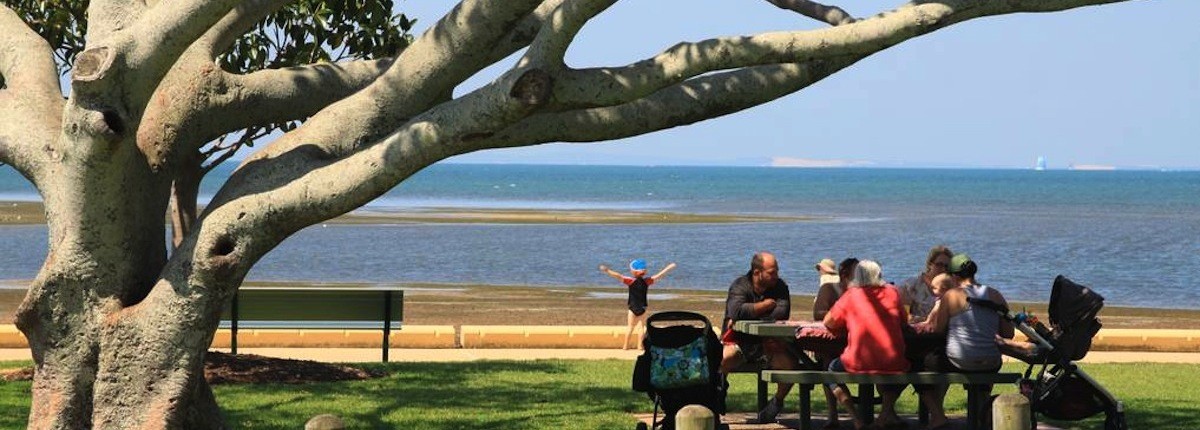Opportunities for Liveable Redlands
The Redlands Garden City
People choose a place in which to live because it has a balance of features they find desirable – they don’t want those features despoiled, they want the balance retained. Redlands has a pleasant equilibrium: a bayside suburb with access to the water, major shopping centres and urban areas – yet it still maintains its partly rural feel
It has expensive homes and canal developments but no gated communities; affordable homes but no big multi story or high density development. These features are why many people who were born here choose to stay and why many others move here from around Australia and the rest of the world.
Residents are not against development: a cinema, new shopping centres, a new library at Victoria Point and the Redland performing arts centre, all made sense and were welcome. Infill development is mostly accepted – it uses up land that is among existing developed areas.
For too long, the Redlands City Council has been preoccupied with residential development and it has taken the focus off all the features that make the Redlands such a special place to live. And we’ve ignored the value to be captured from its natural features. What Redlands needs is a vision for the future, where everyone is involved in bringing ideas and concepts to the table. One such idea is the Garden City.
What is a Garden City? The garden city movement is a method of urban planning that was initiated in 1898 by Sir Ebenezer Howard in the UK. Garden cities were all about balance; they were intended to be planned, self-contained communities surrounded by “greenbelts”, containing proportionate areas of residences, industry, and agriculture. What some wag many years later called a “Mars community” – a great place to work, rest and play.
The Redlands has the potential to emulate a 21st century version of this admirable concept by getting the balance right between residential development, local industry, agriculture and green spaces. Done right it can make the Redlands safer, healthier and more liveable whilst providing better opportunities for business and employment.
In the following we’ll begin our first tentative steps toward how we think this goal could be achieved. It will provide a much needed focus for Council away from residential development to enable economic, social, cultural and environmental balance. In other words, to provide opportunities and resources that everyone benefits from. However, the functional efficiency and innovation required for such a plan can only thrive in the right intellectual ecosystem, one free of developer funded decision making.
We’ll need help with this so give us your feedback. Redlands doesn’t just have fertile soil, it has many fertile minds. Together we should eventually be able to show how this beautiful, bayside area in which we live – with proper council planning – can set the pace and use its natural resources, its business, history, arts and culture, to become the envy of south-east Queensland.

Some ideas which council could initiate that would be welcomed by residents:
- Ensure improved public transport and road planning – particularly where major new developments are planned;
- Development and promotion of a Tourism plan to realize the natural values of the city to improve employment and returns for local business;
- Accelerated development of cycle pathways;
- Installation of underground power – particularly in high risk areas;
- More Parkland, Playing Fields and a Sports Ground with good seating capacity.
Planning
To achieve our goal of a Garden City, we must make the most of our natural features in the area and preserve them at all costs. Residents of the area who were familiar with how this pretty tree-covered headland at the northerly tip of Wellington Point once looked, were appalled a few years ago to see every tree destroyed and the face of this well-loved landmark morph from bushes and trees full of birdlife into a concrete covered cliff face on all sides.
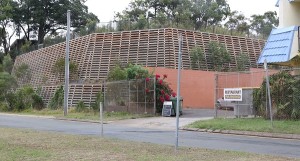
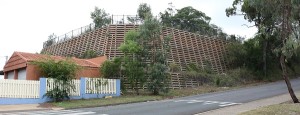
There was an American anti-aircraft gunnery school located there during the Second World War who had strict instructions that no trees were to be removed. It survived its war deployment intact, yet it has now been destroyed.
Council Initiatives that would be welcomed by residents:
Tourism Opportunities
We’ll prioritize our focus on just two islands to begin with because one of them – Straddie – is about to lose the sandmining industry that has been digging up and selling the island’s resources, and has had 65% of the island closed off for the past 70 years. Peel is the other island that has potential for tourism, which can be harnessed in concert with its big neighbour.
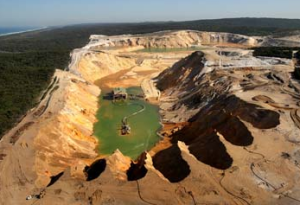
A bridge to Straddie is a big threat to the island which is discussed here, but the other threat the Island faces is the possible extension to sand mining if the State Government fails to act. The cessation of sand mining on the island is a huge opportunity for tourism on the island which, if handled properly, has the potential to more than make up for the loss of the sand mining industry.
And no. We don’t want silly stories about miners becoming builders of the proposed Toondah Harbour redevelopment. If they want to swap their hi-vis vests, there will be plenty of tourism infrastructure to build on Peel and Straddie.
The fact is that Straddie is the only place in Australia where mining leases are sitting on top of a national park and tourism is a far better industry for the island than mining, it’s sustainable and it will benefit everyone in the long term – particularly the Indigenous population.
Tourism in Australia has grown faster than the rest of the economy for every year since 2007-08. Overall, tourism employed over 550000 people throughout Australia last financial year. Mining employs just over 200,000 and is shrinking year by year. Even the arts and recreation industry – which we’ll discuss shortly – employs more folk [247,000] than mining.
Minister for the Environment and Heritage Protection and Minister for National Parks and The Great Barrier Reef Dr Steven Miles, said this was the first step towards a new chapter for North Stradbroke Island, to unlock the island for Queenslanders to enjoy the unique natural and cultural values of this special place and launch new opportunities for the island, its community and economy.
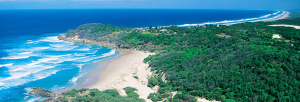
Indigenous cultural activities
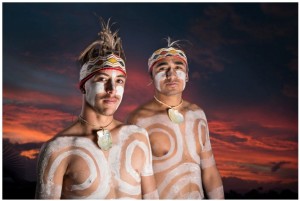
Surveys of international visitors to Australia have shown that interest in Indigenous music, art and dance is consistently at the top of the ‘must see’ activities on visitors’ lists and reasons for their visit. In south-east Queensland there is a well acknowledged scarcity in the tourism sector of such Aboriginal culture. Yet Straddie has some of the earliest human habitation in South-East Queensland and which is continuous. Archeological sites show evidence of the Quandamooka People using the island and surrounding waters for food, work and recreation for over 10,000 years.
Accordingly, many existing activities like the Quandamooka Festival, and Indigenous cultural activities and guided tours could be expanded, along with an Indigenous cultural centre where Indigenous culture and knowledge can be showcased and interpreted. More could be made of the fact that the island was once home to Australia’s best known Indigenous poet Oodgeroo Noonuccal (1920 – 1993). Formerly known as Kath Walker, she was also a political activist, artist, educator and a campaigner for Aboriginal Rights. She was the first Aboriginal Australian to publish a book of verse.
Event & Activity Tourism
Straddie is a great place for surfing championships, whale watching, camping, wildlife tours, and trekking holidays.
They could all benefit from improved council backed infrastructure and marketing.

Straddie is a great place for surfing championships
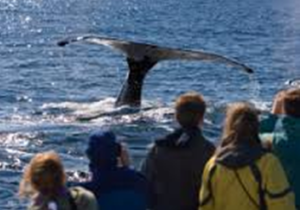
Whale watch cruises by boat. Straddie also has the best land-based vantage points for whale watching in Australia.
Also tours of its abundant wildlife on land and surrounding waters
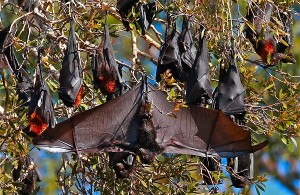


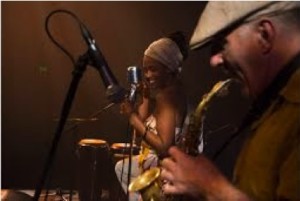
North Stradbroke Island Vibe Festival
Peel Island
There is untapped tourism potential on Peel Island which council should be fostering. Many thousands of years of Indigenous habitation was followed by the use of the island as a quarantine station in the 19th century, followed by a leper colony in the early 20th century. Many of the buildings from this latter era remain in fair condition and some have been restored by QNPWS and asbestos removed. It thus has all the heritage, educational and field study potential of the very popular St Helena Island to its north (27,000+ visitors p.a) but with the added benefits of usable buildings, good camping site potential, plenty of shade and a safe sandy beach. To start with the island requires a jetty so that it can be properly accessed. The Leper colony closed in 1959 – what are we waiting for?
Charterboat & Ferry Access
It’s not just Toondah Harbour that needs upgrading. On the island side, at both Dunwich and One Mile, the stepping off points onto the island require much needed renovations. The ferry terminals at Dunwich and One Mile are the scruffiest and most unwelcoming in Queensland. Moreover, to optimise the enormous potential of the Brisbane visitor market, a fast passenger ferry from the CBD must be part of the plan. Similarly, bay island cruises, Peel Island tours and whale watch cruises could be conducted from North Stradbroke Island itself.
Arts Council Grants
There are good prospects for partnering between the tourism industry and government and there are grant monies available from both state and federal governments. How tourism businesses transform these government support mechanisms into viable enterprises is no easy task but two ongoing festivals on St Helena Island were seeded in the 1990s with Australian Arts Council grants, so it can be done.
Moreover, between them, Peel and North Stradbroke Island tick all the boxes in regard to what is favoured by these funding bodies: ‘Live’ Indigenous culture; early colonial history; vibrant art culture; tourism potential; National Park status and educational opportunities. Separately and in various combinations, these features all have good success rates for winning grant monies.
Another key indicator for seed money is competence and Straddie has the skill sets and a good track record of hosting successful festivals. We need a Council to set the right priorities and incentives that will further expand on existing events and exploit the untapped tourism resources that exist on all our islands. Some of the infrastructure and organizational constraints are outside local government control, like a jetty for Peel Island and its proper gazetting as a functioning National Park. Hence we need a Council that will turn its attention away from residential development and lobby State Government hard on these fundamentals.
Sailing at Deanbilla Bay
The Royal Qld Yacht Squadron (RQYS) at Manly is Queensland’s biggest yacht club and is host to many national and international sailing regattas. The club has a Sailing Academy that teaches sailing to students from schools around Brisbane and plays host to many youth training camps for teams from Junior and Youth through to Olympic level from Australia and overseas.
There are existing sheds, buildings and land, currently leased by the sandmining company, Sibelco at Deanbilla Bay, just south of Dunwich which includes accommodation and large storage sheds.
RQYS has made an application to turn this area into a sailing facility and live-in camp with the idea of using part of the bay south of Peel Island as staging ground for sailing in all its forms, including introductory sailing programs, sail racing and as a regatta destination.
See: http://karenwilliams.com.au/images/uploads/RQYS_DeanbillaBay.pdf
This is an opportunity to grow participation in the environmentally friendly sport of sailing across a wide demographic of competitors and spectators alike. It will provide ongoing employment opportunities to people on the island where around 140 jobs are threatened by the cessation of sandmining and will boost the local economy through increased visitation. It will help provide national and worldwide promotion of North Stradbroke Island for tourism and as a world class sailing venue with first class courses and facilities.
It must pass muster in regard to real estate values and rental agreements; it must be approved by the Quandamooka Yoolooburrabee Aboriginal Corporation who manage the native title interests of the original owners in the area along with other stakeholders on the island. Environmental Impact issues to be addressed for this proposal include assessing the effects of increased boating activity and moorings on oyster leases and adjacent marine habitat. Then there are issues concerning access to anchorages in Deanbilla Bay, general public access to the bay and its foreshores.
RQYS already has a good track record in environmental management in the Redlands. In the late 1980s they acquired ‘Browns’, a run-down 1.1 hectare property on the north-east tip of Russell Island. Take a look at the following to see what has become of it now: http://www.rqys.com.au/about/our-locations/canaipa/
Tourist Information
The Redlands Visitors Information Centre is situated at IndigiScapes at Capalaba. Their staff do a good job, but its out-of-the-way location means that it’s missed by nearly all visitors to the Redlands area. A council with the proper balance of priorities would act as facilitator and properly promote Redlands’ tourism potential in areas where visitors are most likely to be. At minimal cost, small tourist information kiosks could be located adjacent to the areas transport hubs and staffed by volunteers.
Festivals
Adelaide has lost almost 30% of its workforce in the industrial sector in the past 30 years so, in response, the city has been supercharging its cultural sector. There’s a cluster of festivals in Adelaide during late February and March – the Adelaide festival, the Adelaide fringe, Womadelaide, the Biennial and Adelaide writers’ week – which have a transformative effect on the city and its economy. In a report released last month by Festivals Adelaide, the festivals delivered $210m to the state’s economy in 2014/15 – an increase of 16% on the previous year.
Then there’s ticket sales – more than a million tickets were sold to the various activities, according to the report – then there’s the hotel rooms, restaurants and taxis, plus the couple of days many visitors tack on at the end to explore the area. Last year 52,000 interstate and international visitors came to Adelaide in March and in the whole year, 800,000 people came through the Garden of Unearthly Delights.
Rob Brookman, the artistic director of the Adelaide festival and founder of the WOMADelaide festival, says the festival season in Adelaide “acts as a great calling card for the city”. In Australia, what Rob calls the “awesome small city” vibe, has also worked for Hobart, whose arts and tourism sector have been revitalised in a short space of time through festivals and promoting cultural arts.
Vibrant cities like Austin or Portland in the United States have carved out their own niche in various festivals they hold that were initiated by supporting local creatives. Some great festival cities, like Avignon in France and Edinburgh in Scotland, use their festival space to create a carnival atmosphere outside the festival season. They allow for some elements of the festival season – including pedestrian zones, central cultural hubs and pop-up entertainment venues – to run all year. Such creative sizzle could also be initiated by Redland City Council through grants and by cutting the hoops participants have to jump through. Festivals drive tourism and create jobs: festivals in Adelaide generated 790 full-time or 7800 casual equivalent jobs in 2015.
The Redlands is well placed to emulate these examples and to expand on existing festivals. It has an active and varied arts community and the Cleveland town centre would lend itself to becoming a pedestrian only zone to provide venue space. This would also help revitalize the dying business centre. Then there are plenty of add on activities for visitors including the Sirromet winery, boutique brewery, farm stays, scenic drives and visits to the Bay islands and Straddie.
Straddie is very busy in school holidays but has low occupancy rates at other times. The development of new events-based products and scheduling of festivals can help even out seasonality across the year.
Talking of Festivals, now read this:
A MUCH PREFERRED STEPPING OFF POINT FOR NORTH STRADBROKE ISLAND
After properly and carefully evaluating all the concerns related to the siting of the proposed Toondah harbour reclamation, in March 2014, a team of specialist volunteers came up with a grand idea that not only takes the constraints into account but provides untold opportunity. It is to re-site the new depart point for Straddie on the west side of Cleveland Point, an area that already is oriented towards boating facilities [Volunteer Marine Rescue and Redlands Boat Club] and has entrance channels ready made that don’t impact on the bay’s fragile ecosystem. It will add just a few minutes journey time to/from Straddie. But just look what it gives us.
This is a proposal that:
- preserves one of the oldest green reserves in Queensland, the G J Walter Park
- conserves and thus enables us to promote the unique early colonial history of the area
- gives back the grand view to the Grand View Hotel – the oldest and grandest in Queensland
- provides an all-weather harbour that is protected from the elements – no risk of barges going aground
- will restore the important Toondah marine environ. [Existing channel cuts through seagrass meadow, coral habitat and significant Ramsar bird feeding site for endangered shorebirds]
Above all, it gives the Redlands an historic, waterside precinct with bay views intact and priceless bay breezes that stretches from the Grand View Hotel all the way down to include the ugly and dysfunctional Toondah Harbour site. With a mangrove boardwalk, it could even go further through to the Nandeebie and Oyster Point Parks. This bayside parkland can become the City’s unique focal parkland that will provide a premier site for events and festivals. Then, for the rest of the year, provide a beautiful green space that will serve as a reminder that the Redlands community and its Council have together set the right priorities and not given in to big business.
Why Tourism?
When I talk of tourism of course, I don’t mean 5 star hotels, luxury resorts or Club Med, which could detract from the area’s liveability.
The type of tourism I’m thinking of makes the place attractive for visitors and residents alike. Basics like good restaurants, farmer’s markets, cycle paths, walking trails and mangrove boardwalks, public transport, a capacity sports ground, parkland, arts, cultural and heritage precincts, festival and event venues etc.
Tourism development requires a Council to set the right priorities and incentives, reduce red tape, provide the right infrastructure and facilities and listen to the community and the various stakeholders.
As an example of what tourism can do, take the case of Mackay. In 2013/14, the city recognized that the resources boom was coming to its end, so it took action to recoup lost prosperity through tourism promotion. Despite the region having no iconic tourist attractions, it increased its domestic visitation in 2015 by almost 20% and Queensland visitor numbers alone went up 25%. And that’s just in the first year of its new tourism plan.
North Stradbroke Island
We need to focus our attention on North Stradbroke Island because it’s losing its main industry with a loss of 140 jobs. Cessation of sand mining on the island was originally legislated in 2011 to conclude in 2019. But this was extended in 2013 by the short-sighted Newman Government – heavily lobbied by the mining industry – out to 2035. The Annastacia Palaszczuk led Government sensibly brought this back to 2019 but this means that there are now just 3 years in which to undertake all the necessary infrastructure planning before mining ceases.
Mackay’s success can be emulated here. The Queensland Government has already developed a worthy Draft North Stradbroke Island Economic Transition Strategy supported by 16 actions, which aim to:
- drive sustainable tourism
- expand education and training opportunities
- foster business development and growth
They have allocated $20 million to drive this strategy and facilitate stakeholder co-investment to deliver a sustainable economy. The strategy is further supported by an additional $3.87 million in-kind Queensland Government contribution for identified actions and $5 million to help mine workers pursue new employment opportunities. This is an opportunity for mine workers to acquire new skills over the next year or two and make the transition to tourism. And these sums are in addition to any expenditure required on items such as policing, national parks or roads.
The State Government involvement in these tourism opportunities can only take it so far, the initial direction, motivation and ideas have to be locally generated. In seeking to promote such innovation-led growth, it is fundamental to understand the important roles that both the public and private sector have to play. In the first instance the public sector can work from the top down via the aforementioned strategies and they can also incentivize private sector-led innovation through subsidies, tax reductions, grant monies and in building the necessary infrastructure. The rest has to come locally from the ground up.
The State Government set up a Committee to oversee the Amendment Bill but it was made up solely of State MPs. But transitioning to tourism is not like planning a change to an industry with a single focus like manufacturing or mining, it has to involve the local community, business and tourism operators in the first instance. This is because tourism development is complex as the industry relies on a wide array of small niche markets, so planning for growth in tourism must be similarly wide ranging and very carefully managed with input from all stakeholders.
The instigators and facilitators of all the necessary local input must be the Redland City Council itself and it’s in this respect where there are grave concerns with the priorities that the last council team, led by Karen Williams, set in the past four years with its one-eyed focus on residential development, its lack of proper community consultation and its failure to listen to the science and experts in the field.
A functional and properly led council team that understood the issues, would appreciate that the big prizes shouldn’t all go to those who develop and build in the Redlands, help can be given to those who can create something from its natural assets. Heritage, cultural and nature based tourism brings local employment opportunities and provides income that helps preserve our natural assets and provides amenities for us all.
Already there have been scandalous delays in getting Straddie tourism proposals even discussed, let alone planned. Redlands City Council have been missing in action when it comes to exploiting tourism opportunities in the Redlands generally but particularly in regard to Straddie and Peel Island.
At the Public Forum at Cleveland on the ‘North Stradbroke Island Government Bill’ held on 10th February 2016, it was stated that it would take 22 years for the tourism industry on the island to make up for the shortfall in sand mining revenue after 2019, but that was at tourism’s present growth rate. But the present growth rate is at a snail’s pace because of the constraints it’s working under.
There are over 3,000 campers on the island in peak season and the island’s camp sites get overcrowded and they are desperately short of infrastructure. At the Main Beach camp site there are no facilities – not even composting toilets or drinking water. At Flinders beach there are just composting toilets but no other facilities. The island is also under extreme pressure from 4WDs and camping so there is need to open more of it up and establish more camp sites.
North Stradbroke Island is the second biggest sand island in the world and we should be taking more care of it. Straddie is popular as it has what both Fraser and Moreton Islands have got but is closer to the main population centres and easier to get to. Also, unique for a sand island, to access some of its campsites, a 4WD is not required.
Below you will see visitation statistics that confirm what many tourist operators in the Redlands and surrounding areas generally, have been saying for decades: that Straddie is chronically under-marketed and lacks the necessary branding as a tourist destination. The peak tourism bodies of Brisbane, Queensland and the Commonwealth have also echoed these sentiments many times over the years. All these bodies will help in marketing the island both in the domestic and international markets.
Straddie Tourism facts
The island attracts an estimated 350 000 visitors per year with as many as 70 per cent of visitors being return visitors. Domestic overnight visitors make up the majority of visitation to the island (75 per cent) with day-trippers (22 per cent) and international overnight (three per cent) accounting for the remainder. There is an extraordinarily low conversion rate of the Brisbane visitor market of just three per cent per year.
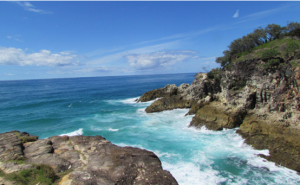
This means that just 3 tourists out of one hundred, who visit Brisbane are visiting Straddie. Yet there huge numbers of Brisbane visitors that head to the Sunshine Coast and Gold Coast from Brisbane just to visit the surf and ocean beaches each year. Similarly the south-east Queensland resident market of just five per cent per year, screams with opportunity, as does the average visitor spend per day on the island, estimated to be just $20 per person. (In fact this figure beggars belief and would normally only apply to the most self-sufficient campers). Most tourists in Australia would spend more than $20 on breakfast.
The final figure that highlights the lack of awareness of Straddie’s attractions – particularly among interstate and overseas visitors – is the seasonal variation in occupancy rates. The peak season rate of around 85 per cent drops to around 10– 15 per cent during the off-peak season. The only tourist destinations in Queensland that have this rate of decline are ones that have good reasons that relate to weather extremes, like those that exist in and around Longreach and Winton. Whilst Straddie of course has good weather all year.
What does it all mean?
Straddie is in close proximity to two of the biggest tourist draw cards in Australia: The Gold Coast (902,000 visitors annually) and Brisbane (1.126 million visitors annually) These are big numbers for us to tap into. The visitation figures for Brisbane alone easily outstrips Cairns, Port Douglas, the Great Barrier Reef, the Whitsundays and Townsville combined. Moreover Brisbane’s numbers increased 13% in 2015. Not to forget of course, the 3.4 million potential visitors that live in south-east Queensland.
How many visitors to the Gold Coast realize how close they are to the second largest sand island in the world, or that they have the chance of seeing koalas, kangaroos, rays and turtle in their natural setting? How many Brisbane visitors know that Straddie has the closest surfing beaches to the CBD? Properly managed and marketed, the tourism industry on Straddie has the potential to tap into these two international tourist drawcards and easily make up the shortfall from the cessation of mining to make a massive contribution to the island’s and Redland’s future.
– Underground Power –
Just look at the strangely shaped trees we have in the Redlands due to powerlines
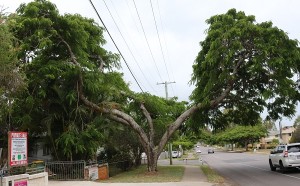
Imagine the Redlands without unsightly powerlines, phone lines and cable tv lines strung between poles nearly everywhere.
Look at how beautiful our trees look when there are no power lines
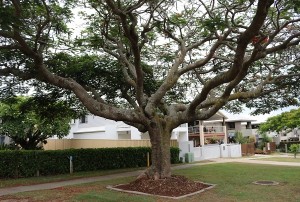
Streetscapes look so much better without them 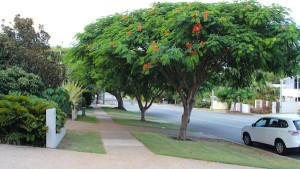
Then think of potential lives saved:
The Black Saturday bushfire that destroyed Marysville in Victoria in 2009, left 40 dead. The Coroner said a power line between two poles had snapped and fell, electrifying a fence and igniting the vegetation.
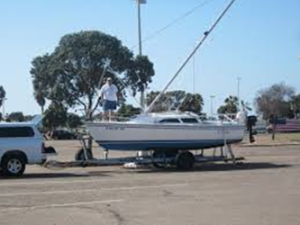 Many more are killed each year when cranes or sailboat masts touch powerlines. It’s dangerous to have power lines in industrial areas. Or in high wind areas or where their is very tall or wind prone trees. You don’t even need to touch overhead power lines to get electrocuted – electricity can arc from power lines, particularly in wet weather.
Many more are killed each year when cranes or sailboat masts touch powerlines. It’s dangerous to have power lines in industrial areas. Or in high wind areas or where their is very tall or wind prone trees. You don’t even need to touch overhead power lines to get electrocuted – electricity can arc from power lines, particularly in wet weather.
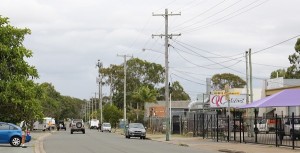
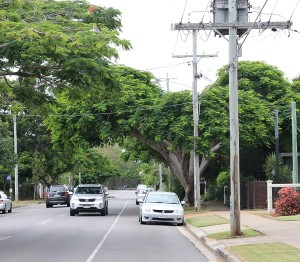 Then there’s the danger to balloon flights and children retrieving model aircraft and flying kites
Then there’s the danger to balloon flights and children retrieving model aircraft and flying kites
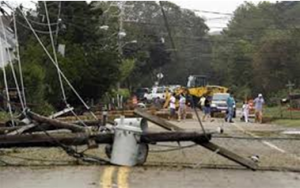 More are killed when powerlines fall following a storm or when tradesmen accidentally touch a powerline when working on the roof. Plus the inconvenience to businesses, shops and homes following blackouts after a storm.
More are killed when powerlines fall following a storm or when tradesmen accidentally touch a powerline when working on the roof. Plus the inconvenience to businesses, shops and homes following blackouts after a storm.
Not to mention the internet, phone and cable TV that go down with it.
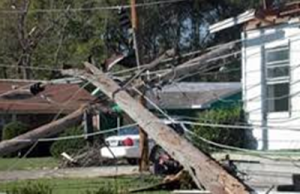 Thousands of properties in central Queensland were without power after Tropical Cyclone Marcia hit in February 2015. 42,000 people were without power – some for up to 10 days. With enormous disruptions to industry, schools and homes and hundreds of tons of food spoiled
Thousands of properties in central Queensland were without power after Tropical Cyclone Marcia hit in February 2015. 42,000 people were without power – some for up to 10 days. With enormous disruptions to industry, schools and homes and hundreds of tons of food spoiled
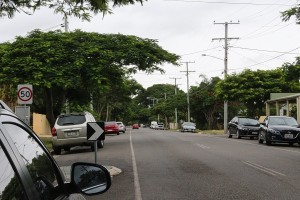 There are dozens of Energex crews working non-stop throughout the State pruning trees away from powerlines. And just look at the strange shaped trees we have in the Redlands as a result:
There are dozens of Energex crews working non-stop throughout the State pruning trees away from powerlines. And just look at the strange shaped trees we have in the Redlands as a result:
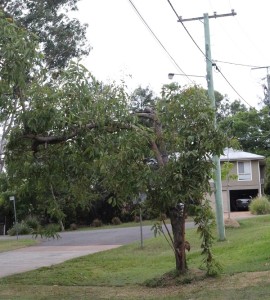 These lopsided trees are ugly. They’re also out of balance – so more likely to get blown down in storms.
These lopsided trees are ugly. They’re also out of balance – so more likely to get blown down in storms.
Australia is one of only a few countries in the developed world having above ground powerlines in storm prone urban areas. Above ground power is only acceptable in remote, sparsely populated areas. Installation of underground power is particularly important in high risk areas, where there are strong winds and tall trees or near boat launching sites, recreational areas and industrial zones.
Above ground powerlines are not just deadly to humans, it also kills wildlife – particularly possums – by electrocution.
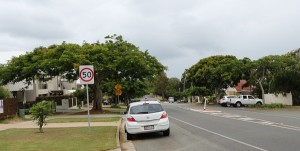 Not only is it safer, more convenient and aesthetically more pleasing to put power underground, but in the long run it is actually cheaper. Ongoing maintenance costs are lowered and there are no costly repairs required after storms.
Not only is it safer, more convenient and aesthetically more pleasing to put power underground, but in the long run it is actually cheaper. Ongoing maintenance costs are lowered and there are no costly repairs required after storms.
This neat little box is where all the cables are safely stored and accessed which are currently strung between power poles. 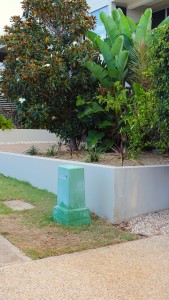
Councils can work with Energex to get powerlines underground. It was a council initiative, under the last Redlands Mayor, Melva Hobson in 2008, that a large part of Dunwich on North Stradbroke Island was converted from overhead powerlines to underground power as part of a Suburban Improvement Project. This project was initiated by the Redland City Council and was jointly funded by Energex who are well aware of the community benefits of having power put underground and are willing to work with councils to achieve it.
Getting power underground can be achieved by a joint funding initiative with Energex, the Council and those residents in particular streets willing to pay a small rate levy, spread say over 5 – 10 years.
See the end of segment on Cycle Paths to see how this cost can be further reduced
– Cycle Paths –
Improved and properly planned cycleway and walkways have the potential to:
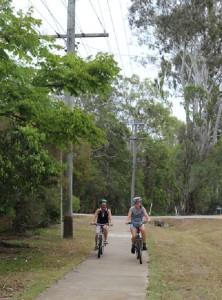
- Improve safety;
- Reduce pollution;
- Improve community health;
- Provide easy access ; and
- Improve business opportunities.
Improve Safety
In October 2013, Michelle Smeaton, 31, was cycling along Old Cleveland Rd when she was hit by a truck, knocking her on to the road. Michelle – mother of two – suffered massive head injuries and died at the scene.
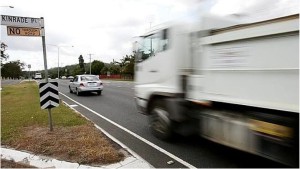
Take a look at the narrow gap between the truck and the edge of the road that Michelle had to negotiate on her bike.
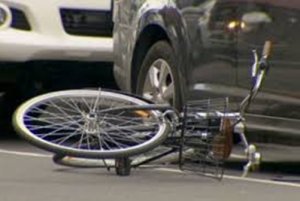
Australia had 61 cycling fatalities in 2014, a toll that had increased on average 17% year on year over the previous four years. After a cycling fatality, there’s a lot of talk of the 1 metre rule and of inconsiderate drivers, but international studies have shown it’s the absence of dedicated cycle lanes that are the main cause of death and injury to cyclists. In Europe where bike use is far higher than here, they have found that separating bikes from motorised traffic by using uninterrupted cycling lanes is the single most important factor.
Sharing cycle lanes with parked cars is dangerous
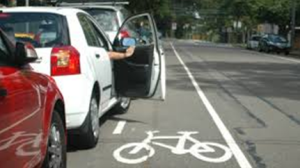
Separate cycle lanes eliminates over 20% of accidents involving bikes: car doors being opened in the path of cyclists.
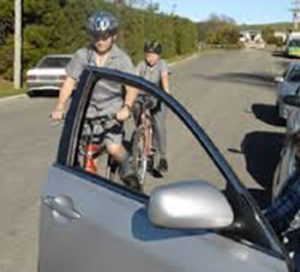
Here in the Redlands, we’ve only gone half way with cycle lanes, they are confusing and dangerous. Cycle paths finish abruptly alongside signs that nobody reads:
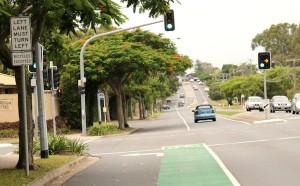
Cycle lanes end at roundabouts and then there are signs indicating lane changes as in the following picture
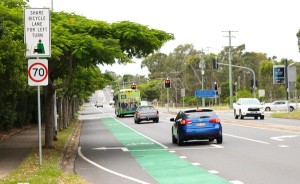
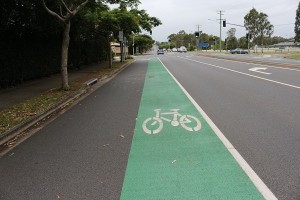
There are cycle paths that suddenly disappear 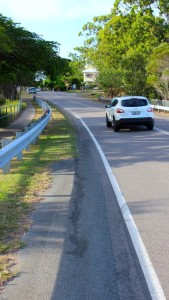
And where is a cyclist to go here?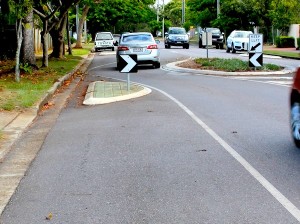
There are many cycle paths alongside busy roads
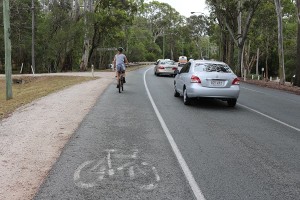
The cyclist is wedged, literally and metaphorically, between the footpath and the road – judged to be too fast on one side, too slow on the other. And yet, along with public transport, the cyclist is the only one offering a solution to the transport gridlock.
Studies show that the fatality rate for cyclists varies in inverse proportion to the amount of cycling done. In countries where people cycle a lot, cyclists have a far lower fatality rate. Australia has one of the lowest participation rates in cycling, (about 1% of all journeys) yet for distance traveled, has one of the highest fatality rates.
This phenomenon of safety in numbers can be seen throughout Europe. Figures compiled by various studies show that in Denmark, top of the continental league for cycling, the average person rides over 10 times further than his British peer every year but runs only 20% of the risk of being killed.
The reasons for this inverse correlation are better cycling infrastructure in areas where more people ride and the fact that if car drivers also occasionally cycle they are likely to be more careful with bike riders.
In Denmark or the Netherlands, cyclists have dedicated cycle lanes and right of way over powered vehicles when they cross paths. As can be seen from picture below, separating cycle paths from traffic really isn’t that difficult to achieve.
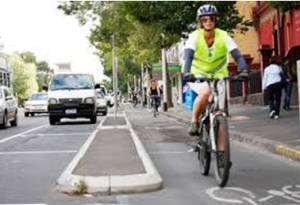
Throughout the world, cycling is increasingly feted as a potential congestion and pollution game changer in major cities. Take the segregated bike lanes currently under construction in the centre of London, for example, or the introduction of protected cycleways in New York, where pedestrian and cyclist injuries are down and traffic is moving quicker.
Stephen Hodge, a former professional cyclist who now works for Australia’s Cycling Promotion Fund, says “The one unifying measure everyone agrees on, that has been shown to increase both perception and actual safety of cycling, is infrastructure such as cycleways.” Sydney’s Mayor, Clover Moore says: “…cycleways are essential for fixing congestion and protecting people who choose to ride.”
Spain remains far from a paradise for bikes – yet cycling has increased 11-fold in Seville in the space of a few years just by building an ambitious network of connected, segregated bike lanes. For many years Seville had only about 0.5% of journeys made by bike, with roads choked by four rush hours a day, due to siestas. The average number of bikes used daily in the city rose from just over 6,000 to more than 70,000.
What bike friendly cities like Seville have found, is that the provision of bikeways is the cheapest way for a city to address its traffic problems. Bike paths are a lot easier to construct than bridges, tunnels and road building schemes.
Reduce Pollution
Huge benefits accrue from encouraging cycle use. Look at the estimated effects of a one-third reduction in the number of car trips from 44% to 30% of all trips in a city:
- 30% less traffic jams,
- 36% reduction in carbon monoxide (CO2) emissions,
- 56% reduction in nitrogen dioxide (NO2) emission
In Canberra, in the five years up to 1981, cycling increased 240% due to the provision of cycle paths. Cyclists rightly feel unsafe when cycling on roads with high posted street speeds. In most US cities for example, the modal share for cycling struggles to reach 2%; in Davis, California, where they’ve built a network of bike paths, it’s 20%. That’s well on the bike path to 25%, the average modal share for cycling in the Netherlands.
Improve community health
[pic of older male on bike] Cycling is also far healthier for the individual. In a study of 9,400 men in sedentary occupations, the 70% of men who cycled at least an hour a week were found to have an incidence of coronary heart disease less than half that for non-cycling men.
All the medical evidence suggests increased exercise leads to improved health. Where quality bikeways have been built use has increased dramatically.

For everyone’s sake we need to get the balance right between car and bike use. All parts of the Redlands including the islands are ideal for cycling: it is reasonably flat and it would ease road congestion in busy times.
A good place to start would be to get safe cycle paths to every school in the Redlands. It would take hundreds of cars off the road during peak times.
In many areas, the bike paths on the road is not used but cyclists use the footpath instead as it’s safer. And in many areas, wide grass verges could easily accommodate a bike path.
Improved Business opportunity
One only has to look at the bikes and riders at Wellington Point at weekends to see the benefits to the local shops and cafes and this has much more potential. We already have the making of excellent and scenic tourist rides but they are not complete and in many places cyclists share busy roads with vehicular traffic.
Savings achieved when underground power and cycle paths done together
As can be seen in these photos, powerlines often use up space that can be used for cycle paths – particularly when verge space is limited. It makes sense therefore for these two objectives to be achieved together to save money. And these should be streets that are done first, as they normally on busy roads.
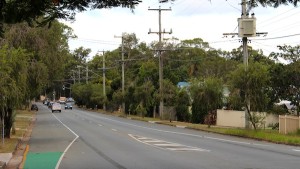
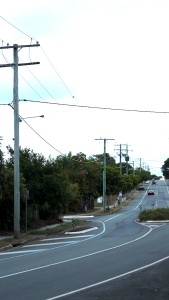
– Walkability-
As well as making the city safe for bikes, we need to make it walkable also. There are many road side areas with no proper footpaths and too many that are shared with bikes.
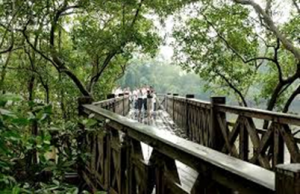
Redlands is also short of mangrove boardwalks, bayside footpaths and fishing/boat jetties when compared to other bayside areas like the Redcliffe Peninsular, Shornecliffe or the Lota-Manly-Wynnum waterfront.
– Public Transport –
 Any study of a city’s transport system from anywhere in the developed world, will show that they can only achieve minimal congestion in peak hour through the use of separated cycle paths and passenger rail transport. Either conventional rail, underground rail or light rail.
Any study of a city’s transport system from anywhere in the developed world, will show that they can only achieve minimal congestion in peak hour through the use of separated cycle paths and passenger rail transport. Either conventional rail, underground rail or light rail.
Traffic engineers have shown that building more bridges and tunnels and widening roads and all the other so called solutions directed towards vehicular transport, simply adds to the traffic problem over the long term by attracting evermore traffic. The general idea that cities need to adjust to the car is so 1970’s. What we want is for the car to adjust to the city.
The work of urban scholars at RMIT, the late Paul Mees and Lucy Groenhart, has proved how pivotal train systems are to the basic functioning of Australia’s increasingly congested major cities.
Bus transport also adds to the traffic problem unless they’re in 100% dedicated bus lanes throughout their journey. If they’re in bus lanes for a while then pop back onto normal roads – as they do in Brisbane and surrounding areas – they cause more traffic problems than they solve. Many areas of Brisbane and its adjoining areas regularly grind to a halt in peak hour and Redland’s traffic is becoming a major problem.
The Cleveland Rail line reaches capacity in peak times because of having only a single track from Manly to Cleveland. This prevents any real worthwhile express services during peak hour. A proper express service that twin tracks would facilitate, would enable the journey time to Brisbane CBD from Cleveland, stopping at just 4 stations, to be cut by 35 minutes and thus would clearly attract a lot more patronage than the single track could ever enable. Twin tracking would also prevent line closure when maintenance work is being carried out and the costly chartering of buses to replace trains.
It could be said that this is out of Council control, but on matters like this that would relieve traffic on the roads and get a much better service from the CBD, Council should collaborate with Brisbane City Council and lobby hard to get the Cleveland line twin tracked.
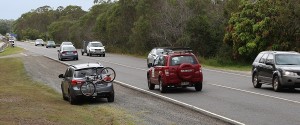
Twin tracks would help overcome the severe traffic problem that exists between Thorneside and the Wynnum/Manly/Fisherman Islands areas. We have a very recalcitrant neighbour alongside us: the Brisbane City Council, who have shown no interest in upgrading the only road – the Green Camp Road – from the Redlands into the Manly area. Or in making the Rickertt Road Bridge [above] into a double lane. Green Camp and Rickertt Roads become gridlocked at peak hours.
Stop Press! We have just heard that there is a joint Redland Council and Brisbane City Council pledge to widen Green Camp Road. Brisbane’s Lord Mayor Graham Quirk has promised to spend $1.3 billion on new road projects including widening the road bottleneck between Redland City and Brisbane, turning four lanes into a larger and easier gateway for commuters using Rickertt Road over on his side of the Boundary sign.
When it comes to public transport, there’s too much talk about urban density; there must be a certain level of density before good public transport can be achieved certainly. But if you look at cities that have good public transport systems, they have achieved it by just making it so efficient with regular and reliable services that it actually entices people away from using cars. And this is the main argument to be used for twin-tracking Cleveland Rail line. Density is of secondary importance. There are plenty of examples of excellent public transport systems in urban areas with densities similar to Redlands City.
Public bus transport in Redlands is not working well. Take a bus ride from the Victoria Point Shopping Centre to Cleveland Rail station and you’ll be taken on a guided tour of Thornlands first. Take a ride on the 40 seater bus that goes to the beach at the end of Wellington Point and invariably the only person you’ll be able to speak to is the driver.
Light Rail
Cleveland is particularly suited to a light rail project. It is reasonably flat and would not entail much alteration to the streetscape. If it were to start where the rail line terminates, it could head for Toondah Harbour
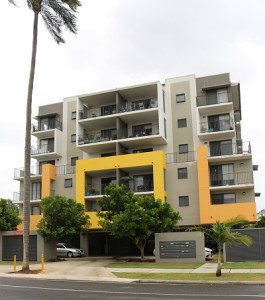 On the way it would pass through – and make a couple of stops in – some of the highest density development in the whole of the Redlands, in the vicinity of Shore Street West
On the way it would pass through – and make a couple of stops in – some of the highest density development in the whole of the Redlands, in the vicinity of Shore Street West
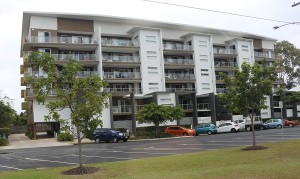
Which also has some of the eldest demographic of the Redlands – who would welcome such a rail link.
A branch line could service the Cleveland town centre. This whole area then could become a mall and be free of vehicular traffic.
In the future it could be extended and head down through Thornlands to the Victoria Point Shopping Centre, before heading to the Bay island ferry terminal at Redland Bay.
 Not all transport infrastructure – road or rail – can be achieved by councils acting alone. It requires integrating local strategies with state planning objectives and sourcing what infrastructure funding is available and making approaches to different levels of government.
Not all transport infrastructure – road or rail – can be achieved by councils acting alone. It requires integrating local strategies with state planning objectives and sourcing what infrastructure funding is available and making approaches to different levels of government.
Now would be a good time to start a conversation with the newly appointed Federal Government Minister for Cities, Greg Hunt. The Federal Government has agreed to back the expansion of the Gold Coast Light Rail project, with PM Malcolm Turnbull, announcing a $95 million grant of federal funding to ensure stage two of the project was delivered.
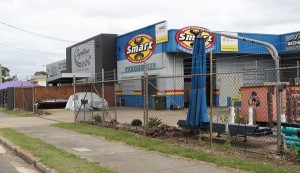
Another way of reducing traffic is to encourage local business development. Creating local employment opportunities obviates the need to travel into Brisbane and elsewhere to work.
As mayoral candidate, Greg Underwood has said:
“For long-term jobs, we need innovative and creative business development to keep residents working here at home.”
Greg’s right:
Making a city an attractive place to live is not incompatible with also making it an attractive place to work. It also reduces traffic problems.
It’s just a question of getting the council decision-making balance right
– Parkland and Playing Fields –
Thanks to the Redland City Bulletin, the community got wind in 2015 of Council’s plan to rezone parcels of conservation, open space and environmental parks. This would have allowed low and medium density development to be undertaken on these green zones. Understandably there was massive public backlash and the Council rescinded in the last Council meeting before Christmas.
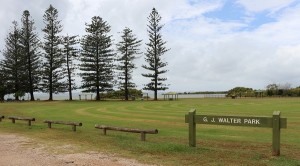 Once again this is a question of balance. We need more parks – not less. The Redlands City Council area is already short of good parkland. The amount of sporting, recreational and environmental parkland is below the average among city and shire councils in Queensland. Many cities are in fact defined by their beautiful parkland. Redlands is almost unique among major city council zones in not having a major central park.
Once again this is a question of balance. We need more parks – not less. The Redlands City Council area is already short of good parkland. The amount of sporting, recreational and environmental parkland is below the average among city and shire councils in Queensland. Many cities are in fact defined by their beautiful parkland. Redlands is almost unique among major city council zones in not having a major central park.
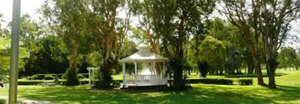 Also a forest of scientific papers shows how access to urban green spaces and the natural environment enhances mental and physical wellbeing. Children particularly need a safe play environment
Also a forest of scientific papers shows how access to urban green spaces and the natural environment enhances mental and physical wellbeing. Children particularly need a safe play environment
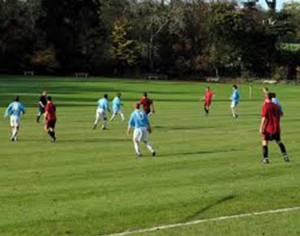 Moreover, there is a chronic lack of playing fields in the Redlands. Adequate sports fields for our growing population have not been included in the community and land use planning done by Mayor Williams. Moreover, Redlands is unique among major city council zones in not having a major sporting venue with any meaningful seating capacity.
Moreover, there is a chronic lack of playing fields in the Redlands. Adequate sports fields for our growing population have not been included in the community and land use planning done by Mayor Williams. Moreover, Redlands is unique among major city council zones in not having a major sporting venue with any meaningful seating capacity.
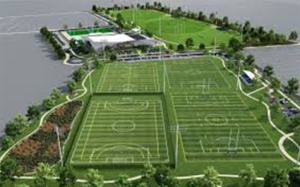 In 2008, the previous Mayor, Melva Hobson, worked with the State Government to complete a sports facility study and Council subsequently approved plans for a major sporting facility in Thornlands. It was to include a six court tennis complex, and 25 playing fields for all sports. The project was removed from Council’s Capital Works program after the last election as Mayor Karen Williams described it as “Ill timed.”
In 2008, the previous Mayor, Melva Hobson, worked with the State Government to complete a sports facility study and Council subsequently approved plans for a major sporting facility in Thornlands. It was to include a six court tennis complex, and 25 playing fields for all sports. The project was removed from Council’s Capital Works program after the last election as Mayor Karen Williams described it as “Ill timed.”
Yet there are a number of sporting clubs who are turning away potential players – because there is no room for them to play. A situation you would not find in central London or New York. As Councillor Craig Ogilvie has said, “access to sports fields is nothing short of an Australian birthright”.
What is the reason for this reluctance by Council to set aside land for leisure purposes? Well, parks and playing fields use up space that can be rezoned for the type of bricks and mortar residential development that is so beloved of our current Mayor, Karen Williams.
Luckily Williams’ plans for developing the land where two of the oldest homes in the Redlands are situated, the Willards Farm property in Birkdale, was thwarted by a public outcry that they should be preserved. These 153 year old homes were part of the earliest farmsteads in the Redlands and this historic area also is adjacent to the aerial farm where General McArthur announced the end of World War II. It is this writer’s view that this whole area – to include the adjacent Commonwealth land – be made into a botanical garden with those 2 historic homes moved back from the road and made a centrepiece. It could then have an agricultural museum nearby that could exhibit Redlands farming heritage. The total area is large enough to incorporate a sports ground and parkland which will help redress the shortage in the Redlands of these important green spaces.
– Other Innovative Council Decisions
In most of Redlands shopping centres there are empty shops, in all its suburbs there are empty buildings – many have been empty for years. While their use is debated or deferred they could easily be put to good use. Each passing day is a lost opportunity for a temporary art gallery or where a business idea could be incubated or for a community to form or a performance space created.
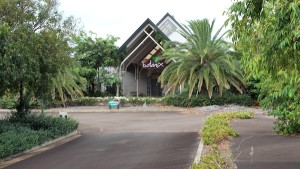
For example, the owner of the disused Botanix nursery at Wellington Point gave permission a few years ago for it to be used for a week or so by one of the service clubs to sell thousands of dollars worth of goods that all went to good causes.
With a rates amnesty for the owner, such empty spaces could be put to productive use. Redlands – and particularly Straddie and the Bay Islands – have a very high proportion of accomplished artists, photographers, potters, sculptors and wordsmiths that would be happy to productively fill these spaces.
Liveability
The foregoing are just examples of a whole range of ‘liveability’ issues that are being ignored by our current mayor, Karen Williams and some of her development-at-all-costs council. Ensure you make your vote count in forthcoming election on March 19th to correct the balance.
Authorised by: Graham Carter
With many thanks for the help provided by the following people
(but all opinions, commentary and mistakes are the author’s)
Voiceovers: Brian Cannon, Carolyn Parsons
Imagery: Ocean Ark Alliance, Lara Rowe
Text: Debra Henry, Simon Baltais, Dr Qamar Schuyler, Dr Sue Pillans, Troy Robbins, Judith Hoyle, Jackie Cooper, Dr Jan Aldenhoven, Noel Dawson, Fiona Maxwell, Dr Doug Moore, Greg Underwood, Wendy Boglary, Craig Ogilvie, Dr Richard Fuller, Jay Donaldson, Peter Simon, David Hannan, Dave and Sue Frampton, Steve MacDonald & the Redlands 2030 team, Redlands Tourism, The Redland City Bulletin, Wildlife Preservation Society of Qld, AMCS … etc …
We believe in a creative commons – the free flow of information. Please share, copy and redistribute the above material in any medium or format for any purpose, even commercially. We just ask that appropriate credit is given and that any changes are made clear.

